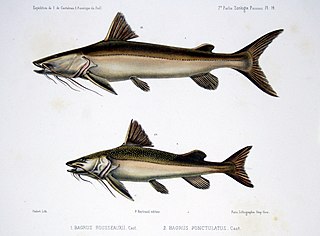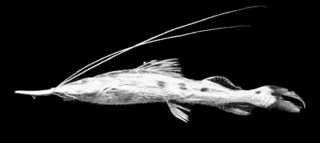
Pseudoplatystoma is a genus of several South American catfish species of family Pimelodidae. The species are known by a number of different common names. They typically inhabit major rivers where they prefer the main channels and tend to stay at maximum depth, but some species can also be seen in lakes, flooded forests, and other freshwater habitats. They have robust bodies, and are important food fish. Recently, their population size has been on the drastic decline due to a variety of factors including overfishing and habitat destruction due to the construction of hydroelectric dams.

The Pimelodidae, commonly known as the long-whiskered catfishes, are a family of catfishes.
Listrura is a genus of pencil catfishes native to South America.

Brachyplatystoma is a genus of catfish from the family Pimelodidae. As the occasionally used common name goliath catfishes indicates, this genus includes some of the largest species of catfish, including the piraíba, B. filamentosum, which reaches up to the region of 3.6 metres (12 ft) in length. Brachyplatystoma are found in the Amazon and Orinoco basins, and other tropical freshwater and brackish habitats in South America. Some species are migratory. These fish are important as food fish and, to some extent, aquarium fish.
Propimelodus is a genus of South American catfish of the family Pimelodidae.

Platystomatichthys sturio is the only species in the genus Platystomatichthys of the catfish family Pimelodidae. It is sometimes called the sturgeon catfish. This species occurs in the Amazon Basin and reaches a length of about 40.0 centimetres (15.7 in) TL. Platystomatichthys is classified under the "Calophysus-Pimelodus clade". Within this clade, it is considered a part of the "Pimelodus-group" of Pimelodids, which also includes Pimelodus, Exallodontus, Duopalatinus, Cheirocerus, Iheringichthys, Bergiaria, Bagropsis, Parapimelodus, Platysilurus, and Propimelodus.

Bagropsis reinhardti is a species of long-whiskered catfish. This species reaches about 22.7 cm (8.9 in) in standard length and is endemic to Brazil where it is found in the Das Velhas River basin in São Francisco River drainage. It is considered a threatened species by Brazil's Ministry of the Environment.
Exallodontus aguanai is a catfish species of the monotypic genus Exallodontus of the family Pimelodidae. This genus and species was described in 1991. This species reaches 20 centimetres (7.9 in) SL. This species is native to the Amazon and Orinoco River basins of Brazil, Colombia, Peru and Venezuela. Exallodontus is classified under the "Calophysus-Pimelodus clade". Within this clade, it is considered a part of the "Pimelodus-group" of Pimelodids, which also includes Pimelodus, Duopalatinus, Cheirocerus, Iheringichthys, Bergiaria, BagropsisParapimelodus, Platysilurus, Platystomatichthys, and Propimelodus.

Pseudopimelodus is a genus of catfishes of the family Pseudopimelodidae.

Platysilurus is a genus of long-whiskered catfishes native to South America.
Tridensimilis is a genus of pencil catfishes native to South America.
Tridentopsis is a genus of pencil catfishes native to South America.
Glanapteryx is a genus of catfishes native to South America.
Pseudostegophilus is a genus of pencil catfishes native to rivers in tropical South America. The members of this genus are obligate parasites that feed on scales and mucus of other fish.
Parastegophilus is a genus of pencil catfishes native to South America.
Schultzichthys is a genus of pencil catfishes native to South America.
Stegophilus is a genus of pencil catfishes native to South America.
Duopalatinus emarginatus, is a species of demersal catfish of the family Pimelodidae that is native to São Francisco River basin of Brazil.
Duopalatinus peruanus, is a species of demersal catfish of the family Pimelodidae that is native to Amazon and Orinoco river basins in Peru.
The Highwaterman catfish, is a species of pelagic potamodromous catfish of the family Pimelodidae that is native to Guyana, Suriname, Venezuela, northern Brazil and Gulf of Paria.






